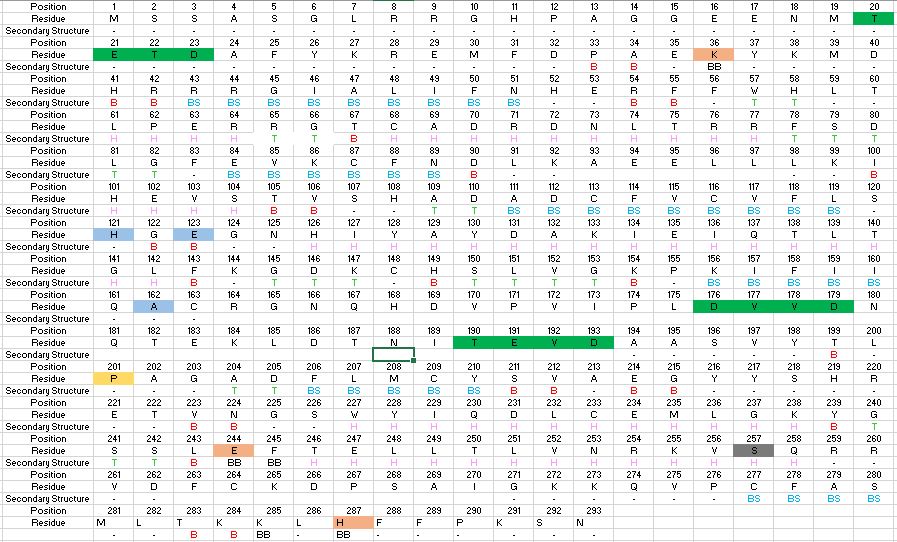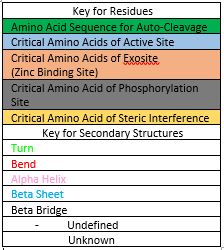User:Luke Edward Severinac/Sandbox 1
From Proteopedia
(Difference between revisions)
| Line 7: | Line 7: | ||
== Zymogen Activation == | == Zymogen Activation == | ||
| - | In addition to a self-cleavage mechanism, Caspase-6 zymogen can be activated getting cleaved by Caspase-3, as well as other enzymes. The mechanism of activation by clevage is highly conserved across the caspase family; Self-processing is uniquely recognized as the primary mechanism for Caspase-6 activation, where clevage must occur at two sites for complete activation, specifically the pro-domain and the intersubunit linker. These cleavages are both sequence specific and ordered. First, pro-domain must be cleaved. (Some residues of the pro-domain are not visible in the crystallized structure) Then cleavage of the intersubunit linker occurs, cleaving both DVVD179 and TEVD193. To some extent the pro-domain inhibits Caspase-6's ability to cleave the intersubunit loop and self-activate; It has been proposed that this sequence of cleavage is due to the pro-domain being more readily available to enter the active site. The result of the TETD23 cleavage site priority is that the | + | In addition to a self-cleavage mechanism, Caspase-6 zymogen can be activated getting cleaved by Caspase-3, as well as other enzymes. The mechanism of activation by clevage is highly conserved across the caspase family; Self-processing is uniquely recognized as the primary mechanism for Caspase-6 activation, where clevage must occur at two sites for complete activation, specifically the pro-domain and the intersubunit linker. These cleavages are both sequence specific and ordered. First, pro-domain must be cleaved. (Some residues of the pro-domain are not visible in the crystallized structure) Then cleavage of the intersubunit linker occurs, cleaving both DVVD179 and TEVD193. To some extent the pro-domain inhibits Caspase-6's ability to cleave the intersubunit loop and self-activate; It has been proposed that this sequence of cleavage is due to the pro-domain being more readily available to enter the active site. The result of the TETD23 cleavage site priority is that the pro-domain acts as a “suicide protector”, which protects the TEVD193 cleavage site from self-cleavage[3]. This protection is necessary when there are low levels of inactive proteins, which must be preserved, in the tissue. The intramolecular cleavage of TETD23 and DVVD179 or TEVD193 are essential for the initiation caspase-6 activation without other caspases present. After both cleavages occur, the processed Caspase-6 can be found in solution as a dimer of dimers. |
==Active State== | ==Active State== | ||
In order to function as an endoprotease, Caspase-6 binds a <scene name='75/752344/Protein_ligand_real/1'>ligand</scene>, which can include neuronal proteins and tubulins [https://en.wikipedia.org/wiki/Tubulin], in its active site.[[Image:Binding grove active caspase 6.png|100 px|right|thumb|Substrate binding grove in Caspase-6. Blue - catalytic residues | In order to function as an endoprotease, Caspase-6 binds a <scene name='75/752344/Protein_ligand_real/1'>ligand</scene>, which can include neuronal proteins and tubulins [https://en.wikipedia.org/wiki/Tubulin], in its active site.[[Image:Binding grove active caspase 6.png|100 px|right|thumb|Substrate binding grove in Caspase-6. Blue - catalytic residues | ||
yellow - ligand | yellow - ligand | ||
| - | red - generic surface]] This binding groove contains three critical amino acid residues necessary to perform cleavage of the peptide bonds. Together, <scene name='75/752344/His121_real/1'>His-121</scene>, <scene name='75/752344/Glu123_real/1'>Glu-123</scene>, and <scene name='75/752344/Cys163_real/1'>Cys-163</scene> form a <scene name='75/752344/Catalytic_triad_real/1'>catalytic triad</scene>. In the theorized mechanism, His-121 acts as an acid catalyst, Glu-123 acts as a base catalyst to deprotonate Cys-163, which then acts as covalent catalyst. | + | red - generic surface]] This binding groove contains three critical amino acid residues necessary to perform cleavage of the peptide bonds. Together, <scene name='75/752344/His121_real/1'>His-121</scene>, <scene name='75/752344/Glu123_real/1'>Glu-123</scene>, and <scene name='75/752344/Cys163_real/1'>Cys-163</scene> form a <scene name='75/752344/Catalytic_triad_real/1'>catalytic triad</scene>[[Image:Cystine Aspartase.png|100 px|right|thumb|active site mechanism]]. In the theorized mechanism, His-121 acts as an acid catalyst, Glu-123 acts as a base catalyst to deprotonate Cys-163, which then acts as covalent catalyst. |
| - | + | ||
==Zinc Inhibition== | ==Zinc Inhibition== | ||
Caspase-6 function is inhibited by the binding of a <scene name='75/752344/Zinc_caspase-6/1'>zinc</scene> ion[https://en.wikipedia.org/wiki/Zinc], which binds to an <scene name='75/752344/Caspase6_allosteric_site/1'>allosteric site</scene> instead of the <scene name='75/752344/Caspase6_allostericactiv_site/1'>active site</scene>. This allosteric site is located on the outside of the protein and is distal to the active site. The zinc ion is bound to <scene name='75/752344/Caspase6_allosteric_site_resid/1'>three amino acid residues</scene>, Lys-36, Glu-244, and His-287. Once the ion is bound to the protein, it is then stabilized by a <scene name='75/752344/H20_zinc_binding_casp/1'>water molecule</scene>. The binding of zinc at the exosite is suggested to cause a conformational change in the protein from an <scene name='75/752344/Catalytic_triad_real/1'>active state</scene> to an <scene name='75/752344/Inactive_catalytic_triad_casp/1'>inactive state</scene> that misaligns catalytic residues and inhibits activity of the enzyme. The residues in the active site no longer provide ideal interactions with the substrate and therefore, substrate does not bind. Zinc binding to the exosite is tightly regulated as it inhibits Caspase-6's critical role in initiation of apoptosis. | Caspase-6 function is inhibited by the binding of a <scene name='75/752344/Zinc_caspase-6/1'>zinc</scene> ion[https://en.wikipedia.org/wiki/Zinc], which binds to an <scene name='75/752344/Caspase6_allosteric_site/1'>allosteric site</scene> instead of the <scene name='75/752344/Caspase6_allostericactiv_site/1'>active site</scene>. This allosteric site is located on the outside of the protein and is distal to the active site. The zinc ion is bound to <scene name='75/752344/Caspase6_allosteric_site_resid/1'>three amino acid residues</scene>, Lys-36, Glu-244, and His-287. Once the ion is bound to the protein, it is then stabilized by a <scene name='75/752344/H20_zinc_binding_casp/1'>water molecule</scene>. The binding of zinc at the exosite is suggested to cause a conformational change in the protein from an <scene name='75/752344/Catalytic_triad_real/1'>active state</scene> to an <scene name='75/752344/Inactive_catalytic_triad_casp/1'>inactive state</scene> that misaligns catalytic residues and inhibits activity of the enzyme. The residues in the active site no longer provide ideal interactions with the substrate and therefore, substrate does not bind. Zinc binding to the exosite is tightly regulated as it inhibits Caspase-6's critical role in initiation of apoptosis. | ||
Revision as of 12:08, 18 April 2017
Caspase-6 in Homo sapiens
| |||||||||||
References
- ↑ Velazquez-Delgado EM, Hardy JA. Phosphorylation regulates assembly of the caspase-6 substrate-binding groove. Structure. 2012 Apr 4;20(4):742-51. Epub 2012 Apr 3. PMID:22483120 doi:10.1016/j.str.2012.02.003
- ↑ 2.0 2.1 Wang XJ, Cao Q, Zhang Y, Su XD. Activation and regulation of caspase-6 and its role in neurodegenerative diseases. Annu Rev Pharmacol Toxicol. 2015;55:553-72. doi:, 10.1146/annurev-pharmtox-010814-124414. Epub 2014 Oct 17. PMID:25340928 doi:http://dx.doi.org/10.1146/annurev-pharmtox-010814-124414
- ↑ Wang XJ, Cao Q, Liu X, Wang KT, Mi W, Zhang Y, Li LF, Leblanc AC, Su XD. Crystal structures of human caspase 6 reveal a new mechanism for intramolecular cleavage self-activation. EMBO Rep. 2010 Oct 1. PMID:20890311 doi:10.1038/embor.2010.141



